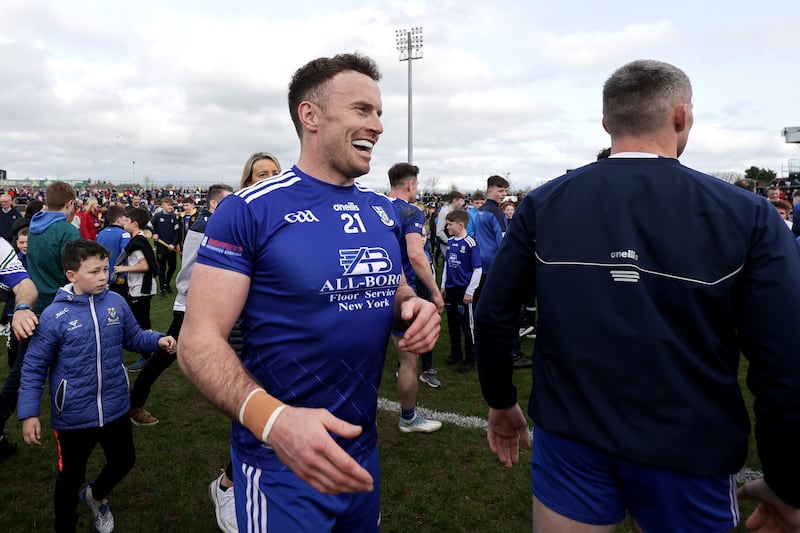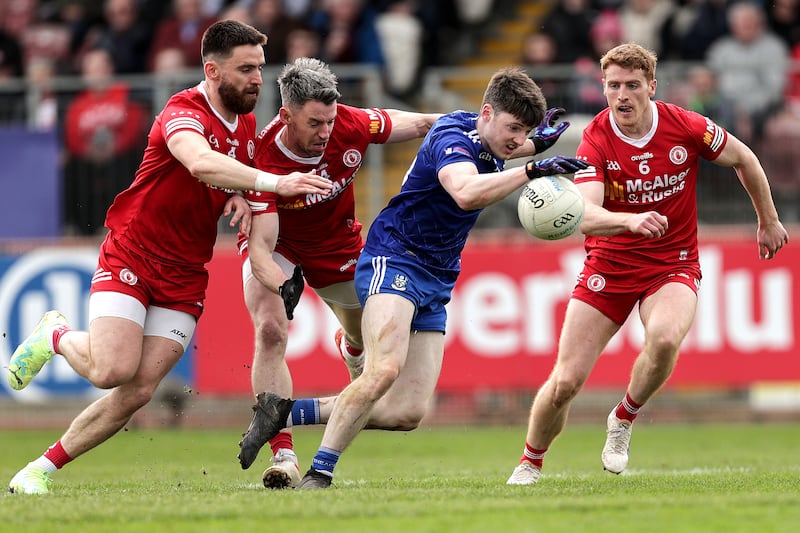Last week, amidst all the rain and hail and occasional sporadic burst of sunshine, I found myself wondering how Tyrone had weathered after what had been a difficult 2022 campaign.
Watching them lift Sam Maguire in 2021, you felt it might be the start of another cycle of success for the county, here was a group of talented young footballers hellbent on emulating the Tyrone teams of the noughties. But last year was such a disaster for them.
In Donegal, on the back of winning the All-Ireland in 2012, we found ourselves in a comparable situation the following season. It was a difficult place because the reality is you don’t truly know what you had until you lose it, and it forces you to look deep inside yourself.
As a result of doing just that, hopefully you come back stronger, but such introspection doesn’t come with any guarantees. Some teams rediscover their spark, others don’t.
READ MORE
As I sat down to watch the game last Sunday, that’s where my head was at on Tyrone – what would they bring to the table? I wanted to see what Tyrone’s response would be to a disappointing 2022.
When the final whistle sounded, the afternoon’s narrative had been penned by Monaghan and their young championship debutant Ryan O’Toole. From a coaching perspective, the 23-year-old’s injury-time goal was the kind of strike that makes you stop and think. It was a moment when youth and fearlessness won out, but clearly the pendulum of the contest could have swung either way in those closing seconds.
In fairness to Tyrone, during the opening exchanges at Healy Park they were very much at the pitch of the game, sharp and hungry, they had the cut of a team ready for championship football. The first score exemplified their attitude, Darren McCurry got possession 40 yards out and swung the ball straight over the bar.

They started with a lot of confidence, they were feisty in the tackle and forced turnovers. They also pushed up aggressively on Monaghan’s kickouts, forcing Rory Beggan to go long.
They were like magnets to any breaking ball around the middle of the park and their goal was a perfect example of the effectiveness of their strategy. Tyrone were able to win Monaghan’s long restarts and then transition quickly.
Niall Morgan’s kickouts were imperious in the first half – he had such variety with shorts, mediums and longs. The longer ones were very well manufactured, releasing midfielders and getting the ball to guys who could win their own ball and then with one further quick pass inside Tyrone were within scoring range. Darragh Canavan is a real talent and he was exceptional in that first half, scoring 1-4 from five shots.
In the opening period Tyrone mixed their style of play well between a strong running game and a strong long-ball game, while they were able to rotate Conn Kilpatrick inside.
Those variables combined to create an effective transitional game, and for me that area was the winning and losing of the contest, because the balance of power in that department switched in the second half.
At the interval Monaghan adapted to the situation strategically very well and as a result in the second half they were the team creating scoring chances through quick transitional play.
The way the game has gone, normally it’s an attacking function against a defensive function. You’ve seen the formation where 13, 14 or 15 players are back behind the ball while the opposing 13, 14 or 15 push forward to try break them down.
But because Tyrone were able to force Monaghan to go long with their kickouts in the first half, and then win the possession, it created transitional opportunities and allowed the home side to attack quickly.
They created these transitional moments in two other ways also – by making contact and turning the ball over, and by winning their own long kickouts and quickly moving the ball forward. In those moments Monaghan hadn’t the capacity to get set up at the back.
It was the 15th minute before Tyrone were actually forced to go inside with an established attack against an established, structured Monaghan defence. And in fairness to Tyrone, that didn’t deter them either as the last two scores of the half came from such phases of play.
The only negative from a Tyrone perspective at half-time was they weren’t already out the gate by that stage because Monaghan had been living off scraps and frees.
Still, for all their good play, there were some red flags for Tyrone in that opening half.
Early on there was a one v one situation in front of the Tyrone goal and Morgan had to come out and punch the ball to safety.
I spoke earlier about the common defensive structure teams are deploying within the game at the moment. Sitting in the stand you might see 13, 14, 15 men back and think no more of it than recognising the fact there are a shedload of players standing between the ball and their goalkeeper.
But that’s not the full story, because you can have 13 men back in a zonal defence inside their 45 metre line or you can have 13 men back inside their 45 but man to man orientated instead. The optics are almost identical but the implications for attacking play can be significant. From early on, because Tyrone favoured the latter, there were openings for Monaghan to exploit.
Also, coming towards the end of the first half Monaghan had started to get their shorter kickouts away with more success. Tyrone had a good press, but Monaghan began manipulating the play by setting up in a central plank and then having players break away for Beggan to target.
Vinny Corey and the Monaghan management used half-time very astutely, they got a lot of stuff sorted. Firstly, the most basic thing of all, they upped the ante and matched Tyrone’s intensity.
They also moved to a zonal defensive structure and were more compact and connected, which Tyrone found very difficult to break down.
Monaghan pushed up very aggressively on Tyrone’s kickouts in the second half. The sort of fluency and variety Morgan had in the first half disappeared and he was forced to go longer with more restarts than he might have liked. Monaghan hunted those breaks down and consistently forced turnovers.

They also changed it up on their own kickouts by pulling more players towards their goal and allowing Beggan to go long over the Tyrone press, where Monaghan could secure possession high up the field. Suddenly it was Monaghan benefitting from transitional moments. Everything had flipped.
Beggan made a positive impact when he joined the Monaghan attack as a plus one and his dinked ball inside led to the creation of Stephen O’Hanlon’s goal. O’Hanlon still had a lot of work to do but he finished with real conviction. It set up an exciting finale and there were big scores from both sides in the clutch moments. Tyrone looked like they had done enough to edge it but there was to be one late twist.
I’ve no doubt were it a 29-year-old haring in on goal in that scenario – dying seconds of injury-time with your team a point in arrears – he would have flicked the ball over the bar. There was an element of youth and fearlessness in O’Toole’s decision to take on that shot.
Tyrone were stunned and the look on Morgan’s face seemed to suggest: Did he just do that? Morgan’s positioning was good, he had his angles correct and had a defender to his right. He just wasn’t expecting the shot.
I couldn’t help but think back to 2011 when Dermot Molloy scored an injury-time goal for us against Tyrone when many other players would have taken the point. Had Morgan stopped O’Toole’s shot there would have been serious ramifications for the young lad, but fortune favours the brave. He seized the moment and Monaghan seized the day. But what does it all say about Tyrone?
They did a lot right on Sunday but their failure to adapt in the second half was worrying.
Also, Monaghan kicked 10 points from frees – which was too many for Tyrone to have conceded from a discipline point of view.
Most damning of all, Tyrone conceded 2-9 in the second half. It’s a tally some teams wouldn’t ship over 70 minutes. Those stats are both the second half and the game in a nutshell. From the moment Monaghan made modifications to their gameplan and shut up shop at the back, Tyrone struggled to break them down.
So, do Tyrone still carry a threat for the remainder of the championship? Certainly.
Will any of the big teams want them in their All-Ireland group? Certainly not.
But the biggest question of all, can they get back to their 2021 All-Ireland winning levels?
I sat down before the game last Sunday with that stumper swishing around my head and today as I write this column it remains very much unanswered.
















